Star Date: June 2014
Bali, Indonesia
Hello Dear Family & Friends!
““Apa Kabar – Bagus”
(“How are you? – Good! – Balinese)
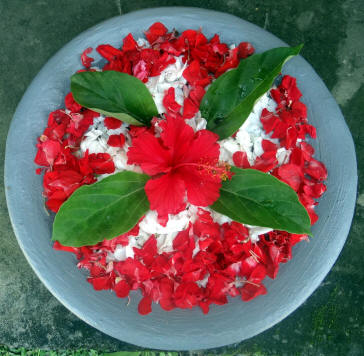
“There comes a time in your life, when you walk away from all the drama and people who create it. You surround yourself with people who make you laugh. Forget the bad, and focus on the good. Love the people who treat you right, pray for the ones who don’t. Life is too short to be anything but happy.
Falling down is a part of life, getting back up is living.” ~
(Jacob Braude)
The history of Bali weaves a story as intricate as the ceremony decorations in the temples. The only Hindu island in the chain of densely populated 2000 Indonesian Islamic islands, the Hindu/Buddhists did not arrive here by choice. A powerful nation on the island of neighboring Java, with magnificent temples and architecture such a Borobudur, they were suddenly threatened by the swarm of Islamic zealots moving across the islands. Fight or flight they decided to flee to the neighboring island, currently Bali. The only people enveloped in the exodus were the royalty, the priests and the artisans. Many Balinese will proudly tell you that they are in fact decedents of one of these three high castes. They simply overtook the residents of their new island of Bali and assimilated them, many farmers, into their life and beliefs.
Fierce warriors through the centuries this culture created a web over the existing agricultural society so that soon living, worshipping, working were tightly intertwined. Control has its benefits for those in charge. Caste systems and slavery were put in place and all the bidding for the royalty was done by the lower 4th class.
Their new society evolved with an abundance of beautiful art, colorful paintings, carvings and unique architecture. An eye for the finer things in life permeates today. Today an estimated 1/3 of a Balinese woman’s life is involved in preparing for, performing the rituals of a ceremony, or dismantling what they have just done. This colorful array around the temples and homes makes Bali an exotic feast for the eyes.
Bali is a bit like an ant hill. Everyone is busy, busy, knowing their job and not questioning; all the while smiling. If there is a breather people sit around together and truly do enjoy life, jokes and family life. Working hard, people are happy when a ceremony happens because even though they are busy with rituals, they get a day or two off work, they get to dress up in stunning, colorful outfits and visit with friends and relatives around the temples. Any money earned is filtered back to the family for guess what? Preparing for more ceremonies or to pay for the community temple. This is a communal, collective society to the nth degree; not unlike the Borg in the New Generation of Star Trek.
We have had young people confess that they would really like to see the world but would never be able. Their whole birth, life and death is already controlled by the priests and the stars. I see a little dissatisfaction brewing, as all societies evolve, but for now the only way to break free is to leave or marry a foreigner. To be without the control of the ‘clan’ is simply not tolerated’. Stepping out of the confines of the family compound is hard but breaking free of the superstitions that are interwoven in their culture from birth is the final step. “If I don’t make a certain offering at this specific time I will end up with bad luck.” Good luck with that one, beliefs die hard!
Four to seven generations have lived in the traditional Balinese family compound surrounding the family temple. The compound is a complete unit from birth to death. No one ever leaves. A woman leaves once – to join the compound of her new husband, hoping she is warmly received by his family. Ideally it is full of security, built in babysitters, financial and religious support. If things go wrong – like an abusive relationship – there is definitely an elephant in the middle of the compound, which everyone tip toes around and never mentions. To leave means cutting ties and becoming a sort of outcast. Still more independent women are realizing their options and cutting free, when the normally controlling but secure life goes astray. Bali is the land of ‘it works until it doesn’t’.
Freedom. This word rang through my head as I broke free from my small, controlling provincial town, hurled out into the wider world and Universe at age 17. My family was understanding because my Mom did the same thing at a young age. It was a wonderful place to grow up, with many good people surrounding me but I never really conformed or fit in and always had my sites on the wider world. I never thought myself better, just different. I read National Geographic rather than Teen Magazine. But there was hell to pay in the community at large once you make the break. “Do you still go to church?” Why did you leave?” “And remember once you do you will never again be accepted as one of us!” Thus the saying, “you can never go home again”. We must make choices. Taking that leap into the unknown was the best thing I ever did! But then I was lucky to have a family that encouraged my free spirit and didn’t pay attention to the gossip or small thinking that is part of any small community worldwide.
That being said, I have very seldom experienced such a joyful, simple, loving society on a whole as the island of Bali. Visit. Enjoy. Respect the culture. And leave the intricacies of the Balinese culture to the Balinese. This is a society that is wonderful to immerse yourself in, up to a certain degree that is. If you build a house next to a cemetery no one will work for you because of wandering spirits. If you don’t follow the guidelines of the temple priests you may find a hex tied on your gate as a warning. And so it goes. Be on this island but not of it. Don’t look too closely!
Life in Bali is inexpensive and draws many visitors and expats. Low prices, balmy weather, cheap labor with a smile. A great combination. In the U.S. the minimum wage yields $15,000usd per year, Australia is $30,000usd per year and Bali is $1,600usd per year. Many other countries pay less such as India $700usd per annum, Congo $500, Malaysia $3,000, China $2,500, Cuba $100. Profits go somewhere but unfortunately not to the average worker.
For tourists many darker elements of history were ignored such as in the 60’s this Island of the Gods was declared a stronghold of ‘communists’ in an Indonesian war. Soldiers raced across the island killing hundreds of thousands of innocent people. Needing a boost and helping with the recovery, tourism became the focus and to this day tourists provide 80% of all revenue on Bali. Bali ranks high as an exotic, cultural, tropical beach destination.
Hoards of Australians flock to the southern beaches such as Kuta. A center for party frenzy Kuta has become a place to roast on the beach and get your hair braided by day and get drunk at night. This was the sad scene of the Bali bombing of a nightclub in the early 2000’s.
Further south is surf central in Uluwatu. We were here in the 90’s when it was just a dusty peninsula with great surf beaches, now it is developing at lightening speed. Up the west coast is Kuta, noisy, congested Denpasar, then Seminyak, all blending into one big traffic jam. Bali is home to several active volcanoes surrounded by big spectacular lakes. The north coast has several grey sand beaches and quaint fishing villages. The east coast is rugged coastline fringed with tropical jungle. Dotted throughout the landscape are verdant green rice fields and temples honoring the gods and Nature.
Bali is one interesting cultural festival after another, at home or in the temple. We enjoyed many visits to the temples and watched as the festivities at surrounding homes progressed. Everyone works together to make the ‘penjour’ or decorate for a birthday, tooth filing ceremony or wedding. “GALUNGAN : is the most important holiday, it symbolize the victory of virtue ( Dharma ) over evil ( A Dharma ) on our heart especially of human being for defeated them self so , on GALUNGAN every family puts of a “ PENJOR “ a tall bamboo pole, placed on the right or left side of the entrance to house compound. Each PENJOR is decorated by each villages such as : woven young coconut instead of oldest coconut , any kind of leafs either from the leaf of coconut or palm leafs , the meaning of the PENJOR is ‘ how to thank to the ancestors on appreciation for prosperity had been given to human being especially in Bali”.
Candidasa is a living example of what not to do ecologically. A sleepy little fishing village until the 1970’s it was ‘discovered’ and became the new beach place in Bali, along with Kuta. As restaurants and bars sprang up the development increased as the beautiful sand beach eroded. Someone had the bright idea to mine the coral reefs offshore for a close supply of lime for the orgy of cement construction. By the 1980’s Candidasa was a beach resort with no beach. Mining stopped in 1992 and a few well placed sea walls have brought back tiny little coves of sand. The coast is still stunning and we enjoyed 10 days in a little ocean view bungalow before heading up to Ubud.
Just a boat ride away from Sanur, the island of Nusa Lembongan is a quaint little place where development has missed thus far. 85% work at farming carrageenan from seaweed, an emulsifier we all love to make our ice cream smooth and creamy.
We usually fly in and spend a few days along the beach in Sanur. The oceanfront path of Sanur is always a fun place to hang out and watch people any time of the day or night. Our little home stay, Julia 1, proved you can never return and find things the same. Ketut was born with a serious limp but had overcome this stigma and was a pleasure to talk with. Over the last 3 years Ketut’s Mother had died, his wife ran off with his money, the rooms had decrepitated, construction noise destroyed the quiet of the courtyard, Ketut had sold many of his competition song birds that had filled the compound with joyous songs. The joy had also gone from poor Ketuts heart and he was a grouch. We wish him well. Life is often a rollercoaster ride. “Falling down is a part of life, getting back up is living.”
Love, Light & Laughter,
“xoxoox Nancy & Joseph

Bali & Cultural Diversities
A note from Joseph:
I was recently talking to a lady in Bali about my visit to Bali with my mother in 1961. I explained to her that all people, both men & woman wore no clothing above the waist. Another lady quickly and with a strong voice said “I work in the villages in remote Bali and the old women tell me that the reason they wore no clothing above the waist was because they were poor”.
That got me really thinking. When I was in Bali 53 years ago, I saw, not one tourist, and Ubud had only 15 or 20 simple wooden buildings and nearly each house had its own loom for weaving all the cloths they could ever need from the local resources for FREE. There was no Monkey Forest Park as monkeys (and forest) were everywhere and people loved to eat them. Almost no one used money in those days, All roads were dirt and no motorcycles and very rarely a car of any kind, so no need for money. The food market was large with 10 times as many fruits and vegetables as you see today, all for barter and exchange.
So what is this lady talking about? We traveled for 10 years to over 40 countries and in 1970 I met my very first tourist, as all the travelers in those earlier days were business men.
It struck me that shortly after we visited Bali tourist and missionaries arrived and told each other that women wearing no tops was crude, uncivilized, and barbaric, and we would not do that in the USA or Europe. The local Bali people said “is that really true” and were told, YES. So the local people instead of saying “we dressed for comfort and had no sex hang-ups or Christian controls” they said “we were to poor for upper cloths”.
Well, I have heard this story many times, after visiting over 150 countries on six continents and being around the World 34 times in a period of 53 years. I have heard the same story in many parts of Africa, South America, Asia, with the Australian Aborigines, North American Native Peoples, etc….
On our home, the Big Island of Hawaii the older local Hawaiians tell of all swimming without any cloths and then the missionaries telling them they must wear a swimming suit, and how they thought that, “That doesn’t make sense, as you just get your cloths all wet”.
Did you know? French ladies of the 1720s found it fashionable not to cover their breasts but to leave them exposed.
The true worth of long term travel cannot be easily understood. Did you ever wonder why all peoples worldwide shake with their right hand only? Well only in the last 100 years have peoples worldwide began to use toilet paper, and invention originally from China, and peoples used to wash themselves after the toilet using their left hand, only. Thus, 30 years ago and some places even today, children that were left-handed were forced to relearn using there right hand and nobody knew why.
As we constantly travel the World over the last 12 years we have seen the indigenous clothes disappear and seen tee-shirts and tennis shoes or flip flops everywhere.
We are becoming a one world culture with less & less diversity.
Enjoy each day…………….Joseph Gill

Travel notes:
1 US Dollar = 11,000 Indonesian Rupiah. It is nothing to withdraw 2-3 million for spending!
Sanur:
Sunset Beach Bar next to Grand Ina Bali Beach (large high rise) near the ferry to Lembongnan. They have a local reggae band that gets everyone up dancing! Lots of fun and their sign says: “Whatever happens here, stays here!”
Can’t recommend Yulia 1 Homestay any longer. Construction noise and since his wife took off with his money Ketut has become grouchy. Oh well. Things change.
Manik Organic Jl Danau Tamblingan 85
organic juice and food
Little Pond Homestay:
Jl Danau Tamblinggan No 19
# 0361 289902
info@elloravillasbali.com
Simple budget, compact homestay (150,000-200,000r)
Still looking for a good, quiet budget home stay in Sanur – please email us with good ones you have found.
Candidasa:
Temple Cafe and Seaside cottages. On the perpetually busy road but down by the water it is divine to lay on a lounge chair and watch the birds fly off into the sunset. Tables for dining are also down on the ocean side. Book on agoda.com for good deals. 0363 41629 $25-$40 night
Good restaurant next to the Iguana Hotel. We would walk down the road briefly to eat there or cut through for a swim at the little cove of sand. The other direction from the Temple Cafe was a little resort on the water with good food and a great Legong dance (free) 2 times a week. Worth an evening outing.
Further down the road on the ocean side at the little night market Joseph loved the gado gado while I had a coconut.
Water Palace Karangesem a surprise treasure along the coast toward Ahmed. Former royalty enjoyed the luxury of a small palace built out into a lake.
Taman Tirtagangga: A great water temple/palace with lovely fountains, stepping stones and bridges.
Uluwatu:
Sandat Mas Cottages – Jl Uluwatu – book through agoda.com Budget rooms a bit worn but swimming pool area upscale and enjoyable.
Land’s End Cafe – kind of organic hippie warung with great smoothies
Don’t miss the Kecak Ramaya & Fire Dance located on the cliffs above the crashing surf, at sunset it is an evening of ancient ritual, beautiful maidens, dance, fire & drama. Watch as Hanoman, the white monkey god, helps to rescue kidnapped Sita and return her to Rama (90,000r p.p.)
Ahmed:
Good Karma Bungalows:
Get the M bungalow – $24 for an ocean view, right on the beach.

Legong dancers.

Dancing is a lovely part of Balinese culture.

On the way to the temple. The path goes between the
rice fields and a rushing little irrigation river.
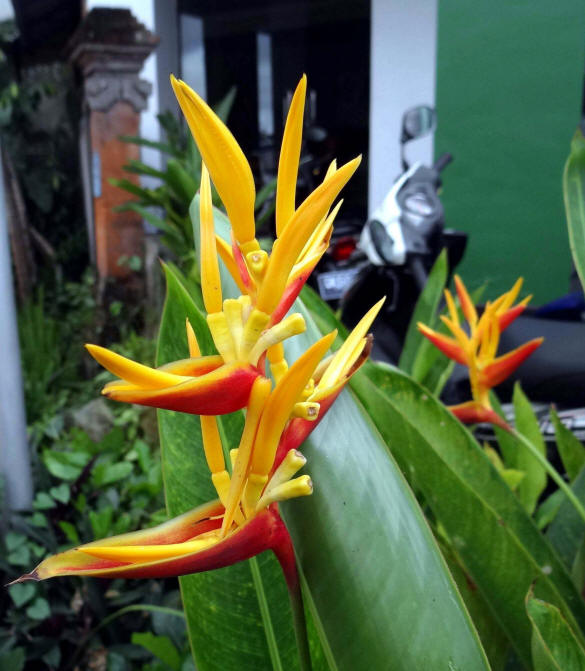
Tropical flowers are everywhere.

Praying to the ancestors.

All day long women in colorful sarongs make
offerings in the temple.

Ceremonies at the temples are a fun, social event after the
offering and praying are finished.

A different outfit is required for each ceremony.

Group prayers with the temple priests.

Mimicking Mom & Dad.

Elaborate gamelan instruments prepared for the ceremony.

Daddy’s little sweetheart.
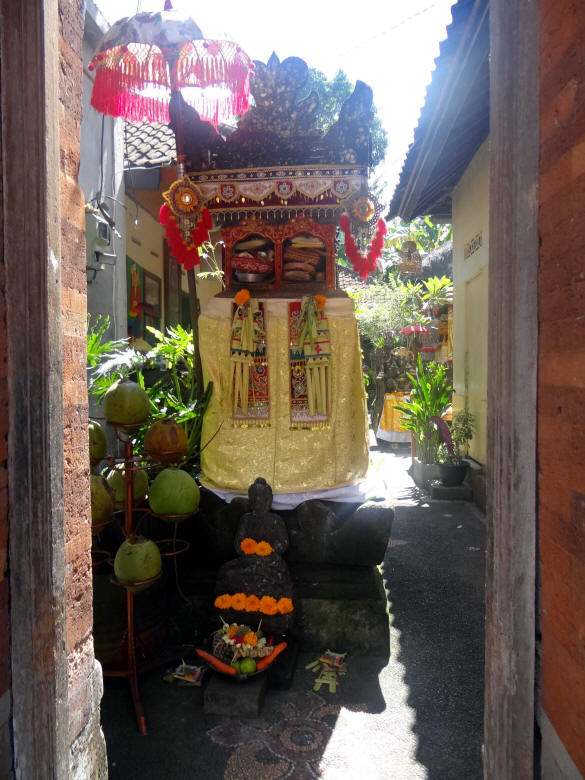
Every courtyard is colorfully decorated during
the many festivals in Bali.

A simple, daily offering. These are placed around the
family compound many times throughout the day.
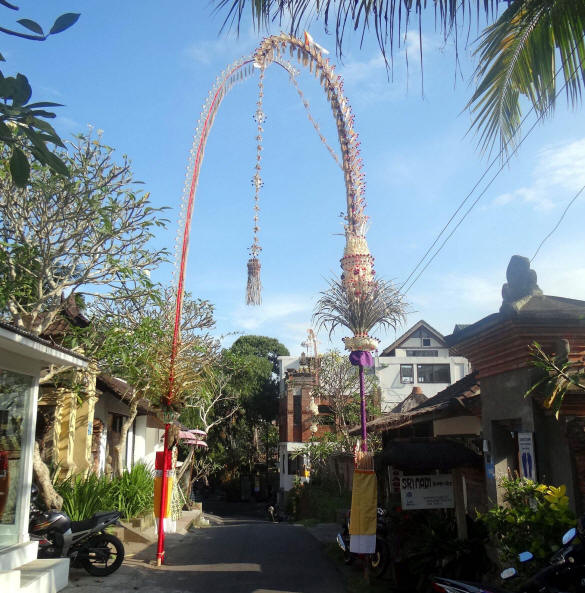
Penjors line the roads during Galungan.

Artists and craftsmen are seen everywhere enjoying their
creativity.

A painting at the gallery at the Blanco Museum.

Carving figures the full length of a 20 ft. log

A god greeting visitors to Monkey Forrest Road.

Boys playing music and acting out a scene from the
Mahabarata.

A dance performance at the Palace in Ubud.

Water lilies at the Water Palace.

Water Palace Karangesem on the way to Ahmed.
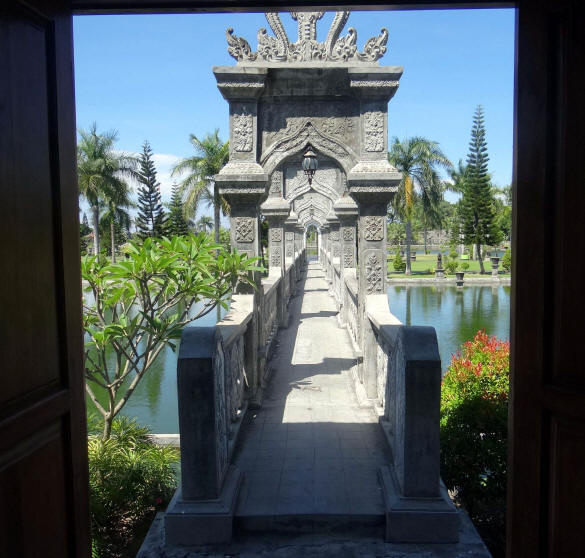
A bridge into the palace.

Royalty lived in this attractive ‘floating’ palace.

Royalty all decked out for a photo.

A spectacular view of the volcanoes behind the palace.

A rainbow in the distance along the
Candi Dasa shoreline.

Temple Cafe.

The cute little daughter at the ‘gado gado’ stall in the
the local evening market.

The Candi Dasa lotus pond.

The lotus is symbolic of life – growing from the mud up to
the light.

Gazebos are a great place to relax in the shade along
the ocean in Sanur.
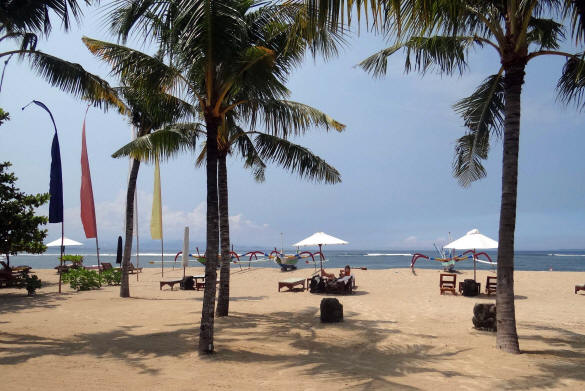
Sanur oceanfront and beach stretches for miles.

